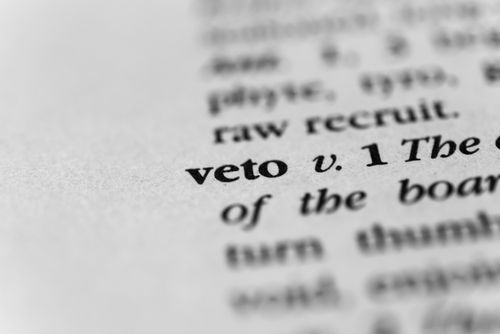Is it me, or is "Veto" starting to sound really good

Our heroes from the previous story, Shapley, Shubik and Banzhaf are on a trip today. They’re going to New York, for the United Nations Security Council meeting. This powerful institution consists of delegates from fifteen member states: five permanent and ten non-permanent. All decisions are made with a minimum of nine (not eight) affirmative votes, and all five permanent members have to give an affirmative vote. That is actually the veto rule: if any permanent member of the Security Council is against the decision, the proposition is dismissed.
An equivalent way of interpretation of the veto rule is as follows. To make a positive decision, 39 votes are needed, where every permanent member state has 7 votes, and each non-permanent state has one vote. Checking that this model is correctly describing the situation from the Security Council is left as an exercise for the reader.
Now, let’s recall what Shapley and Shubik ask for – votes making the decision, pivotal vote. In this model, a non-permanent member state can cast a pivotal vote only if it is casting ninth vote, and all permanent member states already voted. The total number of permutations in sequence of votes is 15!, and for the scenario described in this paragraph, there are 84×6!x8! possible cases (why? There are 84 ways to select the six non-permanent members to vote after the pivotal vote, and 8! ways to permute the members casting the vote before the pivotal vote). Dividing these two numbers gives us the value of 4/2145, or 0.19% power. Multiplying by 10 (number of non-permanent members) and subtracting from 100% we come to the conclusion that the permanent members have more than 98% of power in their hands – 19.6% each.
Now let’s check what Banzhaf has to say. In his index, if you recall, we count the votes that could change the outcome of the vote if they were different. Calculation of those votes gives some more power to the non-permanent members: 1.6% each, leaving 16.7% of power for each permanent member.
Conclusion in both cases is quite clear: the non-permanent members have a tiny part of power in the Council. Before 1965 the power of non-permanent members was even smaller: back then, the Council had 11 members, 5 permanent and 6 non-permanent members. Seven votes were the passing majority. Calculation of Shapley-Shubik index reveals some interesting effects of the 1965 change.
The permanent members had 98.7% total power (19.74% each) and the others had 1.3% (0.22% each). With the 1965 change of non-permanent members’ number, the power of permanent members dropped to 98.14%, and for non-permanent members it grew accordingly. However, the power of a single non-permanent member dropped, since there are more of them now! The ratio of power between a permanent and non-permanent member used to be 1:91.2, and it now changed to 1:105.25.
Next time your country becomes a non-permanent member of the Security Council, have this in mind.
In the next story “Got a problem? Vote!” J. E. Littlewood will help us answer an important question: can our vote decide the election winner?
(The title is a Friends reference.)
This is the ninth in a series of ten articles by the author.
Featured Image Courtesy: Shutterstock
